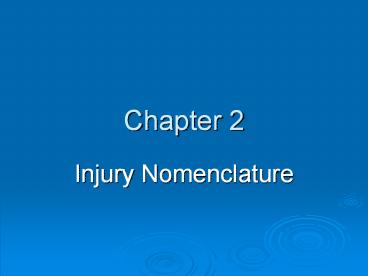Injury Nomenclature - PowerPoint PPT Presentation
1 / 26
Title: Injury Nomenclature
1
Chapter 2
- Injury Nomenclature
2
Soft Tissue Injuries
- Most common form of orthopedic trauma
- Injuries to
- Muscles, Tendons, Skin, Joint Capsules,
Ligaments, Bursae - Affect Performance by
- Hindering joint motion
- Decreasing ability of muscle to produce force
- Creating joint instability
- Limiting amount of motion available to joint
3
Musculotendinous Injuries
- Affects muscles ability to contract fully,
forcibly, or both - Mechanical insufficiency vs. pain
- Partial tear in muscle or tendon
- Decreased force production secondary to pain
elicited during contraction - Complete tear
- Inability to produce any force
4
Strains
- Tensile Forces
- Dynamic Overload
- Three-degree grading scale
- First-degree strains
- Second-degree strains
- Third-degree strains
- Table 2-1, page 31
5
Tendinitis
- Table 2-2, page 31
- Tenosynovitis
- Peritendinitis
- Three-degree grading scale
- Partial or complete tendon tearing
- Calcific tendinitis
- Table 2-3, page 32
6
Myositis Ossificans
- Figure 2-2, page 32
- Formation of bone within a muscle bellys fascia
- Due to traumatic injury
- Very important to differentiate between muscle
strain and contusions versus the formation of
ossification - Table 2-4, page 33
7
Bursitis
- Bursae fluid-filled sacs that serve to buffer
muscles, tendons, and ligaments from
friction-causing structures and facilitate smooth
motion - Table 2-5, page 34
8
Joint Structure Injuries
- Injuries involve the capsular and ligamentous
tissues - Directly affect the joints stability
9
Sprains
- Occur when joint is forced beyond its normal
limits resulting in stretching or tearing of
ligaments, joint capsule, or both - Three-degree grading scale
- Table 2-6, page 35
10
Joint Subluxation
- Partial or complete disassociation of the joints
articulating surfaces - Subsequent episodes
- Apprehension Response
- Table 2-7, page 35
11
Joint Dislocation
- Obvious deformity, Figures 2-3 and 2-4, page 36
- Risk of injury to bony, vascular, neurological,
and other soft tissue structures - Dislocation of major joint medical emergency
- Table 2-8, page 36
12
Synovitis
- Table 2-9, page 37
13
Articular Surface Injuries
- Articular or hyaline cartilage may be injured
acutely or damaged as a result of degenerative
changes - Irreversible, leads to chronic pain and/or
dysfunction
14
Osteochondral Defects
- Fractures of a bones articular cartilage and
progressive softening of the cartilage - Severity based on depth of defect and location
- Table 2-10, page 38
15
Osteochondritis Dissecans
- Dislodged fragments of bone within the joint
space - Talus, femur, patella, capitellum, and humeral
head most frequently affected - Pain, loss of ROM, decreased joint function,
locking - Table 2-11, page 39
16
Arthritis
- Osteoarthritis degeneration of joints
articular surface - Weight-bearing joints
- Regeneration causes bony outgrowths
- Figure 2-8, page 40
- Rheumatoid Arthritis systemic condition
- Table 2-12, page 40
17
Bony Injuries
- Tend to be traumatic
- Proper initial management
- Pediatric and adolescent population
18
Exostosis
- Wolffs Law
- Growth of extraneous bone
- Figure 2-9, page 41
- Table 2-13, page 41
19
Apophysitis
- Growing pains inflammation of bone growth
plate - Figure 2-10, page 42
- Attachment sites for strong muscle groups
- Rapid growth spurt, lack of flexibility
20
Fractures
- Classified based on
- Location of fracture, Box 2-1, page 43
- Magnitude of fracture line, Box 2-2, page 43
- Shape/direction of fracture, Box 2-3, page 44
21
Avulsion Fractures
- Tearing of ligament or tendon from bony
attachment - Small vs. large tendons
- Figure 2-11, page 42
22
Stress Fractures
- Chronic condition (repetitive stress), most
common in lower extremity - Changes in training, equipment, surfaces
- Table 2-14, page 45
23
Neurovascular Pathologies
- Nerves, arteries, veins
- Due to joint dislocation, bony displacement,
concussive forces - Injury can lead to loss of function
- If untreated, vascular injury can lead to loss of
body part
24
Peripheral Nerve Injury
- Entrapment injuries are common at ankle, elbow,
wrist, cervical spine - More distal greater probability of regeneration
- Swelling can cause paresthesia and muscular
weakness - Stretch injuries
- Neurapraxia
- Axonotmesis
- Neurotmesis
25
Complex Regional Pain Syndrome(Reflex
Sympathetic Dystrophy)
- Exaggerated, generalized pain response after
injury - Intense, prolonged pain that is out of proportion
to severity of injury - Prognosis is variable
- Symptomatic relief
26
Imaging Techniques
- Table 2-15, page 47
- Various figures, pages 47-50































